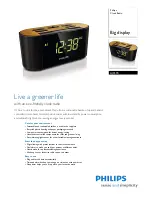
Application Note
4 of 80
002-26071 Rev. *B
2021-09-07
Clock configuration setup in TRAVEO™ T2G family CYT4D series MCUs
Clock system for TRAVEO™ T2G family MCUs
2
Clock system for TRAVEO™ T2G family MCUs
2.1
Overview of the clock system
The clock system in this series of MCUs is divided into two blocks. One block selects the clock resources (such
as external oscillation and internal oscillation) and multiplies the clock (using FLL and PLL). The other block
distributes and divides clocks to the CPU cores and other peripheral functions. However, there are some
exceptions where the RTC can connect directly to a clock resource.
shows the overview of the clock system structure.
Clock distribution/
division
Clock selection
and multiplier
Internal circuit
(CPU core, peripheral functions,
etc.)
Clock sources
(External, Internal)
Clock system
Figure 1
Overview of the clock system structure
2.2
Clock resources
The MCUs support two types of resource inputs: internal and external. Each of these internally support three
types of clocks respectively.
•
Internal clock sources (All these clocks are enabled by default):
−
Internal main oscillator (IMO): This is a built-in clock with a frequency of 8 MHz (TYP).
−
Internal low-speed oscillator 0 (ILO0): This is a built-in clock with a frequency of 32 kHz (TYP).
−
Internal low-speed oscillator 1 (ILO1): ILO1 has the same function as ILO0, but ILO1 can monitor the clock
of ILO0.
•
External clock sources (All these clocks are disabled by default):
−
External crystal oscillator (ECO): This clock uses an external oscillator whose input frequency range is
between 3.988 MHz and 33.34 MHz.
−
Watch crystal oscillator (WCO): This also uses an external oscillator whose frequency is stable at 32.768
kHz, mainly used by the RTC module.
−
External clock (EXT_CLK): The EXT_CLK is a 0.25 MHz to 100 MHz range clock that can be sourced from a
signal on a designed I/O pin. This clock can be used as the source clock for either PLL or FLL, or can be
used directly by the high-frequency clocks.
−
Low-power external crystal oscillator (LPECO): This clock uses an external oscillator. The input frequency
range is between 4 MHz and 8 MHz. The LPECO can be regarded as an ECO operating in low-power mode.
For more details on functions such as IMO, PLL, and so on, and numerical values such as frequency, see the
TRAVEO™ T2G
and the
2.3
Clock system functions
shows the details of the clock selection and multiplier block. This block generates root frequency
clocks CLK_HF0 to CLK_HF13 from the clock resources. This block has a capability to select one of the





































